Cover |
|
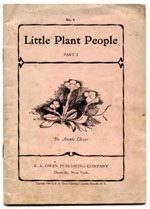
[Full Image] |
No. 1 |
Inside Front Cover |
|

[Full Image] |
Advertising |
1 |
|
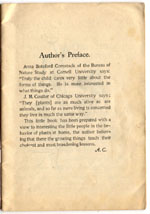
[Full Image] |
Author's Preface. Anna Botsford Comstock of the Bureau of Nature Study at Cornell University says: "Truly the child cares very little about the forms of things. He is more interested in what things do." J. M. Coulter of Chicago University says: "They [plants] are as much alive as are animals, and so far as mere living is concerned they live in much the same way." This little book has been prepared with a view to interesting the little people in the behavior of plants at home, the author believing that there the growing things teach their choicest and most broadening lessons. A.C. |
2 |
|
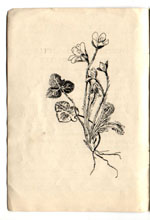
[Full Image] |
Illustration |
3 |
|
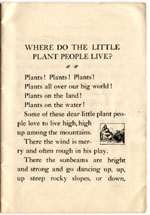
[Full Image] |
WHERE DO THE LITTLE PLANT PEOPLE LIVE? Plants! Plants! Plants! Plants all over our big world! Plants on the land! Plants on the water! Some of these dear little plant people love to live high, high up among the mountains. There the wind is merry and often rough in his play. There the sunbeams are bright and strong and go dancing up, up, up steep rocky slopes, or down, |
4 |
|
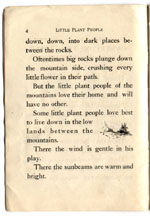
[Full Image] |
down, down, into dark places between the rocks. Oftentimes big rocks plunge down the mountain side, crushing every little flower in their path. But the little plant people of the mountains love their home and will have no other. Some little plant people love best to live down in the low lands between the mountains. There the wind is gentle in his play. There the sunbeams are warm and bright. |
5 |
|
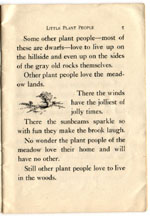
[Full Image] |
Some other plant people – most of these are dwarfs – love to live up on the hillside and even up on the sides of the gray old rocks themselves. Other plant people love the meadow lands. There the winds have the jolliest of jolly times. There the sunbeams sparkle so with fun they make the brook laugh No wonder the plant people of the meadow love their home and will have no other. Still other plant people love to live in the woods. |
6 |
|
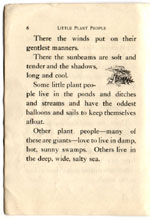
[Full Image] |
There the winds put on their gentlest manners. There the sunbeams are soft and tender and the shadows, long and cool. Some little plant people live in the ponds and ditches and streams and have the oddest balloons and sails to keep themselves afloat. Other plant people – many of these are giants – love to live in damp, hot, sunny swamps. Others live in the deep, wide, salty sea. |
7 |
|
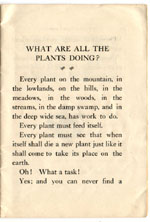
[Full Image] |
WHAT ARE ALL THE PLANTS DOING? Every plant on the mountain, in the lowlands, on the hills, in the meadows, in the woods, in the streams, in the damp swamp, and in the deep wide sea, has work to do. Every plant must feed itself. Every plant must see that when itself shall die a new plant just like it shall come to take its place on the earth. Oh! What a task! Yes; and you can never find a |
8 |
|
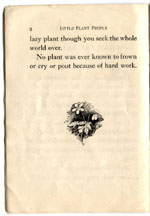
[Full Image] |
lazy plant though you seek the whole world over. No plant was ever known to frown or cry or pout because of hard work. |
9 |
|
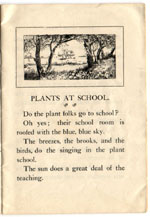
[Full Image] |
PLANTS AT SCHOOL. Do the plant folks go to school? Oh yes; their school room is roofed with the blue, blue sky. The breezes, the brooks, and the birds, do the singing in the plant school. The sun does a great deal of the teaching. |
10 |
|
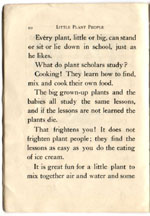
[Full Image] |
Every plant, little or big, can stand or sit or lie down in school, just as he likes. What do plant scholars study? Cooking! They learn how to find, mix and cook their own food. The big grown-up plants and the babies all study the same lessons, and if the lessons are not learned the plants die. That frightens you! It does not frighten plant people; they find the lessons as easy as you do the eating of ice cream. It is great fun for a little plant to mix together air and water and some |
11 |
|
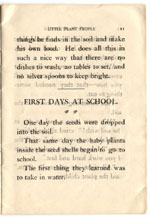
[Full Image] |
things he finds in the soil and make his own food. He does all this in such a nice way that there are no dishes to wash, no tables to set, and no silver spoons to keep bright. FIRST DAYS AT SCHOOL. One day the seeds were dropped into the soil. That same day the baby plants inside the seed shells began to go to school. The first thing they learned was to take in water. |
12 |
|
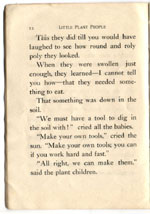
[Full Image] |
This they did till you would have laughed to see how round and roly poly they looked. When they were swollen just enough, they learned – I cannot tell you how – that they needed something to eat. That something was down in the soil. "We must have a tool to dig in the soil with!" cried all the babies. "Make your own tools," cried the sun. "Make your own tools; you can if you work hard and fast." "All right, we can make them." said the plant children. |
13 |
|
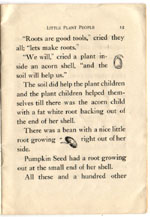
[Full Image] |
"Roots are good tools," cried they all; "lets make roots." "We will," cried a plant inside an acorn shell, "and the soil will help us." The soil did help the plant children and the plant children helped themselves till there was the acorn child with a fat white root backing out of the end of her shell. There was a bean with a nice little root growing right out of her side. Pumpkin Seed had a root growing out at the small end of her shell. All these and a hundred other |
14 |
|

[Full Image] |
first grade children had roots that night when the sun went down. "Good!" cried the sun; "Well done, little people; by and by you shall come up to the light." "If we dig very hard with these soft roots we shall soon spoil them," cried Bean. "We must make the tips of our roots hard and strong," said Acorn. "Yes, put roots on them," cried a Sun Flower child. Then all the children fell to work and made hard tips, to wear at the ends of their roots. |
15 |
|
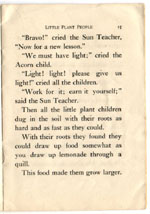
[Full Image] |
"Bravo," cried the Sun Teacher, "Now for a new lesson." "We must have light;" cried the Acorn child. "Light! light! please give us light!" cried all the children. "Work for it; earn it yourself;" said the Sun Teacher. Then all the little plant children dug in the soil with their roots as hard and as fast as they could. With their roots they found they could draw up food somewhat as you draw up lemonade through a quill. This food made them grow larger. |
16 |
|
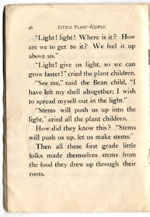
[Full Image] |
"Light! light! Where is it? How are we to get to it? We feel it up above us." "Light! give us light, so we can grow faster!" cried the plant children. "See me," said the Bean child, "I have left my shell altogether; I wish to spread myself out in the light." "Stems will push us up into the light," cried all the plant children. How did they know this? "Stems will push us up, let us make stems." Then all these first grade little folks made themselves stems from the food they drew up through their roots. |
17 |
|
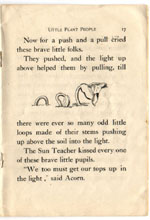
[Full Image] |
Now for a push and a pull cried these brave little folks. They pushed, and the light up above helped them by pulling, till there were ever so many odd little loops made of their stems pushing up above the soil into the light. The Sun Teacher kissed every one of these brave little pupils. "We too must get our tops up in the light ," said Acorn. |
18 |
|
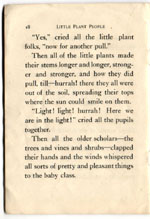
[Full Image] |
"Yes," cried all the little plant folks, "now for another pull." Then all of the little plants made their stems longer and longer, stronger and stronger, and how they did pull, till – hurrah! there they all were out of the soil, spreading their tops where the sun could smile on them. "Light! light! hurrah! Here we are in the light!" cried all the pupils together. Then all the older scholars – the trees and vines and shrubs – clapped their hands and the winds whispered all sorts of pretty and pleasant things to the baby class. |
19 |
|
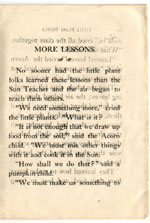
[Full Image] |
MORE LESSONS. No sooner had the little plant folks learned these lessons than the Sun Teacher and the air began to teach them others. "We need something more," cried the little plants. "What is it?" "It is not enough that we draw up food from the soil," said the Acorn child. "We must mix other things with it and cook it in the Sun." "How shall we do that?" said a pumpkin child. "We must make something to |
20 |
|
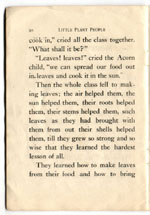
[Full Image] |
cook in," cried all the class together. "What shall it be?" "Leaves! leaves!" cried the Acorn child, "we can spread our food out in leaves and cook it in the sun." Then the whole class fell to making leaves; the air helped them, the sun helped them, their roots helped them, their stems helped them, such leaves as they had brought with them from out their shells helped them, till they grew so strong and so wise that they learned the hardest lesson of all. They learned how to make leaves from their food and how to bring |
21 |
|
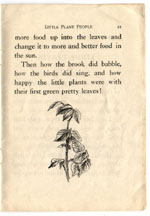
[Full Image] |
more food up into the leaves and change it to more and better food in the sun. Then how the brook did babble, how the birds did sing, and how happy the little plants were with their first green pretty leaves! |
22 |
|

[Full Image] |
SOME SECRETS ABOUT THOSE LEAVES. No wonder the plants were proud of their leaves. They had made them very cunningly. They had made them with little cells to hold food and water and with little openings in them to let air and moisture out and in. Then they had covered the whole with a nice little waterproof covering, both to keep water in and to keep too |
23 |
|
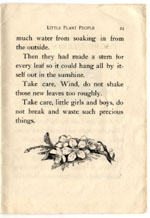
[Full Image] |
much water from soaking in from the outside. Then they had made a stem for every leaf so it could hang all by itself out in the sunshine. Take care, Wind, do not shake those new leaves too roughly. Take care, little girls and boys, do not break and waste such precious things. |
24 |
|
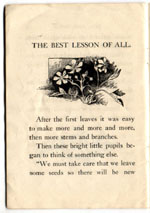
[Full Image] |
THE BEST LESSON OF ALL. After the first leaves it was easy to make more and more and more, then more stems and branches. Then these bright little pupils began to think of something else. "We must take care that we leave some seeds so there will be new |
25 |
|
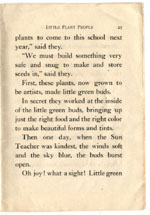
[Full Image] |
plants to come to this school next year," said they. "We must build something very safe and snug to make and store seeds in," said they. First, these plants, now grown to be artists, made little green buds. In secret they worked at the inside of the little green buds, bringing up just the right food and the right color to make beautiful forms and tints. Then one day, when the Sun Teacher was kindest, the winds soft and the sky blue, the buds burst open. Oh joy! what a sight! Little green |
26 |
|
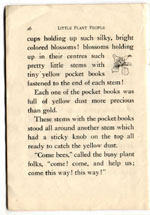
[Full Image] |
cups holding up such silky, bright colored blossoms! blossoms holding up in their centres such pretty little stems with tiny yellow pocket books fastened to the end of each stem! Each one of the pocket books was full of yellow dust more precious than gold. These stems with the pocket books stood all around another stem which had a sticky knob on the top all ready to catch the yellow dust. "Come bees," called the busy plant folks, "come! come, and help us; come this way! this way!" |
27 |
|
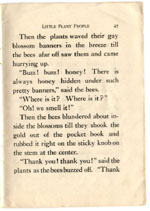
[Full Image] |
Then the plants waved their gay blossom banners in the breeze till the bees afar off saw them and came hurrying up. "Buzz! buzz! honey! There is always honey hidden under such pretty banners," said the. bees. "Where is it? Where is it?" "Oh! we smell it!" Then the bees blundered about inside the blossoms till they shook the gold out of the pocket book and rubbed it right on the sticky knob on the stem at the center. "Thank you! thank you!" said the plants as the bees buzzed off. "Thank |
28 |
|
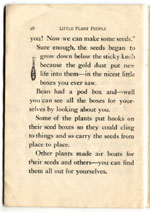
[Full Image] |
you! Now we can make some seeds." Sure enough, the seeds began to grow down below the sticky knob because the gold dust put new life into them – in the nicest little boxes you ever saw. Bean had a pod box and – well you can see all the boxes for yourselves by looking about you. Some of the plants put hooks on their seed boxes so they could cling to things and so carry the seeds from place to place. Other plants made air boats for their seeds and others – you can find them all out for yourselves. |
29 |
|
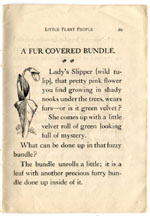
[Full Image] |
A FUR COVERED BUNDLE. Lady's Slipper (wild tulip), that pretty pink flower you find growing in shady nooks under the trees, wears furs – or is it green velvet? She comes up with a little velvet roll of green looking full of mystery. What can be done up in that fuzzy bundle? The bundle unrolls a little; it is a leaf with another precious furry bundle done up inside of it. |
30 |
|
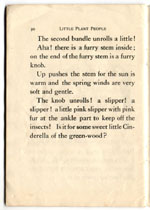
[Full Image] |
The second bundle unrolls a little! Aha! there is a furry stem inside; on the end of the furry stem is a furry knob. Up pushes the stem for the sun is warm and the spring winds are very soft and gentle. The knob unrolls! a slipper! a slipper! a little pink slipper with pink fur at the ankle part to keep off the insects! Is it for some sweet little Cinderella of the green-wood? |
31 |
|

[Full Image] |
PLANT FURS. Many of the plants wear furs to keep out the cold. The furs keep in the moisture too, and keep insect robbers from coming into the honey store house to steal. You would laugh to see an ant trying to climb a furry stem for honey. He climbs up one step, he falls down three steps; he tries it again; he gets tangled in the fur; it brushes his eyes unpleasantly, till, at last down he tumbles and brave as he is, he has to give up that drop of honey, |
32 |
|
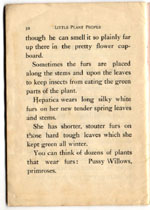
[Full Image] |
though he can smell it so plainly far up there in the pretty flower cupboard. Sometimes the furs are placed along the stems and upon the leaves to keep insects from eating the green parts of the plant. Hepatica wears long silky white furs on her new tender spring leaves and stems. She has shorter, stouter furs on those hard tough leaves which she kept green all winter. You can think of dozens of plants that wear furs: Pussy Willows, primroses. |
Inside Back Cover |
|
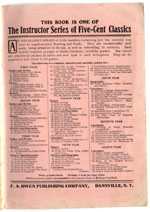
[Full Image] |
Advertising |
Back Cover |
|
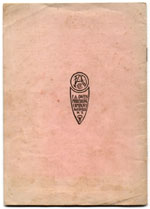
[Full Image] |
F. A. OWEN |